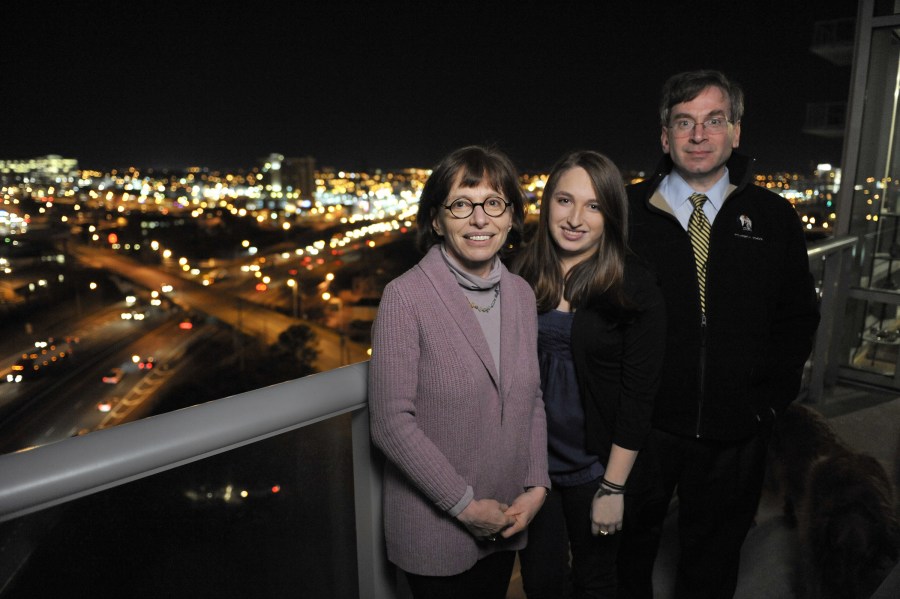
Bonnie Miller, M.D., senior associate dean for Health Sciences Education, at their Gulch-area home with her daughter, Miriam, and husband, Robert Miller, M.D. (photo by Joe Howell)
VUMC Reporter profile: Medical education lifted by Miller’s quiet strength
Sometimes the best measure of success for a leader is what happens on his or her watch.
Upon first meeting Bonnie Miller, M.D., the diminutive, soft-spoken senior associate dean for Health Sciences Education, you might not suspect the key role she played in bringing about the most significant curriculum change in decades at Vanderbilt University School of Medicine.
In 2006, the school embarked on a process of curriculum modification. On occasion, Miller faced a prevailing attitude that the school’s administrators were attempting to fix something that wasn’t broken.
Now, Miller and VUSM have reached the tipping point in the next phase of the curriculum renovation, dubbed “Curriculum 2.0,” which builds on the previous changes, but takes them much further. It introduces novel methods of helping students learn and also aims to create empowered physician-leaders.
“Bonnie is one of those special people who makes Vanderbilt an exciting place,” said Jeff Balser, M.D., Ph.D., vice chancellor for Health Affairs and dean of the School of Medicine. “She is not only a leader in the application of technology to medical education, but also a visionary in the rapidly growing realm of inter-professional health care education. Her efforts have helped propel our School of Medicine into the forefront as we adapt medical education to the radically changing needs of patients and providers in an Internet-enabled society.
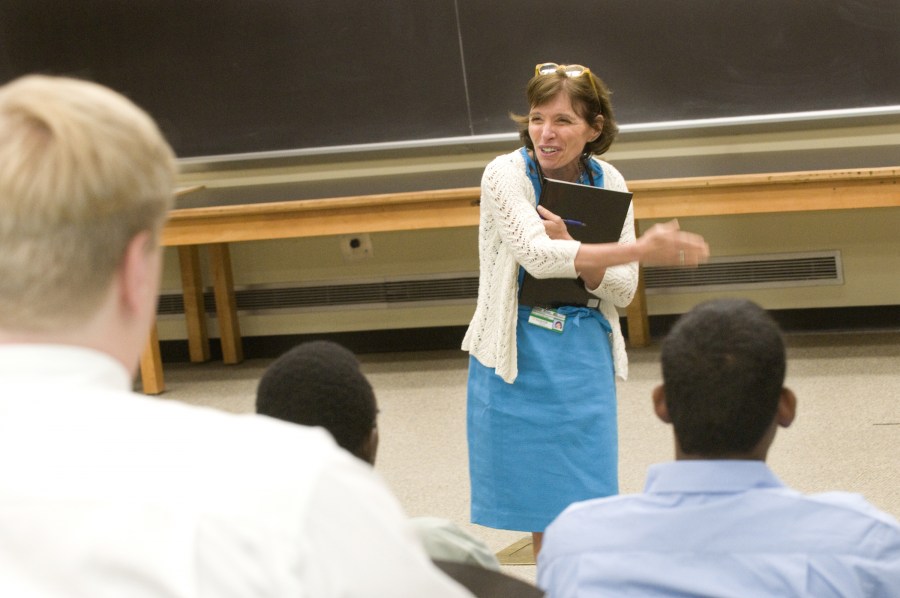
Bonnie Miller, M.D., has been a driving force behind “Curriculum 2.0,” Vanderbilt’s initiative to revamp the way the School of Medicine educates students. (photo by Mary Donaldson)
“Beyond her expertise as a courageous ‘education change agent,’ she is one of the most compassionate and dedicated people I know,” Balser said.
The curriculum will roll out in 2013, and thanks to the faculty and students, it will roll out to an eager and enthusiastic crowd. When it does, Miller won’t be up front taking credit; she will say that the changes are a team effort of faculty and students. But Miller has been the key.
O.R. assistant at age 7
Bonnie Mersky grew up in Dover, Del., the third of four children. By age 7, she was assisting her father, Harold Mersky, DVM, in the operating room as he spayed and neutered small animals in his veterinary clinic next to their home.
Her father’s first love, however, was quarter horses, which he bred, broke, bought and sold from a barn in the backyard. Her mother ran the financial side of the business, which was such a large part of family life that their first major vacation was a trip to Denver to visit a saddle factory.
Fairly naturally for a veterinarian’s daughter already accustomed to working in surgery, she gravitated to premedical training. She attended Colorado College in Colorado Springs, where a “block” structure immersed students in a single well-integrated course at a time, then set students free to recharge by hiking, biking, skiing or sometimes just sleeping. This experience seeded Miller’s fascination with how people learn.
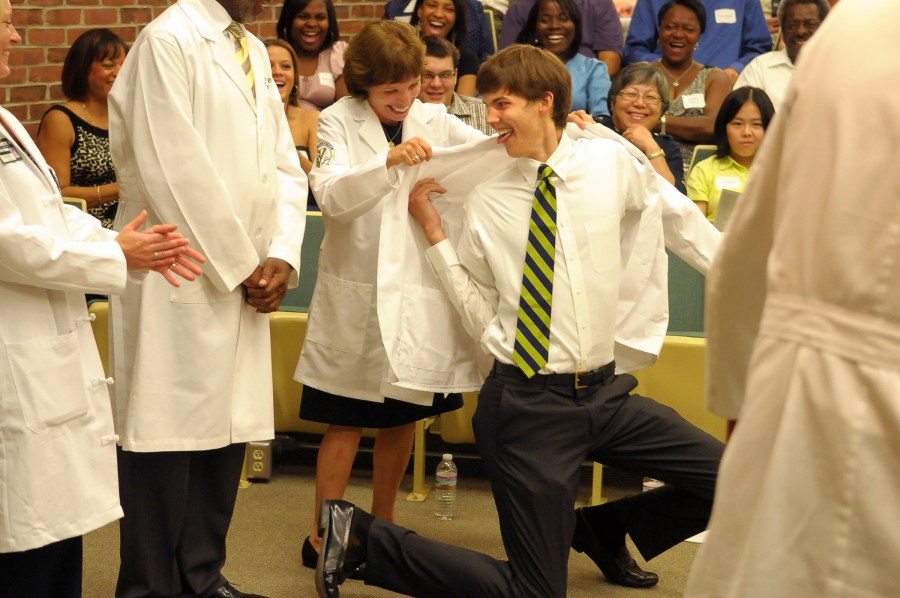
Miller is a fixture at School of Medicine events such as the White Coat Ceremony. In 2010, first-year medical student Dan Tilen, who is 6’7,” had to kneel to receive his white coat from Miller. (photo by Mary Donaldson)
As she fell in love with Pinion conifer vistas and a rhythm of enrichment and learning, she found love of another sort with Robert Miller, a classmate and native of Tulsa, Okla., who shared medical aspirations and a love of the outdoors. The couple moved to Oklahoma for medical school, but it was Nashville, with its beautiful location and Vanderbilt’s assurance the couple could move here together, that won them over.
A sense of balance
Miller’s friends say that even as a young woman she was thoughtful and possessed a rare sense of balance. She went into practice in a general surgery group at Saint Thomas Hospital with another former Vanderbilt chief resident, Jeanne Ballinger, M.D., while also working as a faculty member in the School of Medicine’s Surgery program.
John Tarpley, M.D., who directs the surgical residency program, appreciated that Miller was someone who sought balance between the science and art of medicine. Later, the two joined forces with the chaplain at Saint Thomas to offer a monthly meeting where students openly discussed concerns about the complexities of medicine.
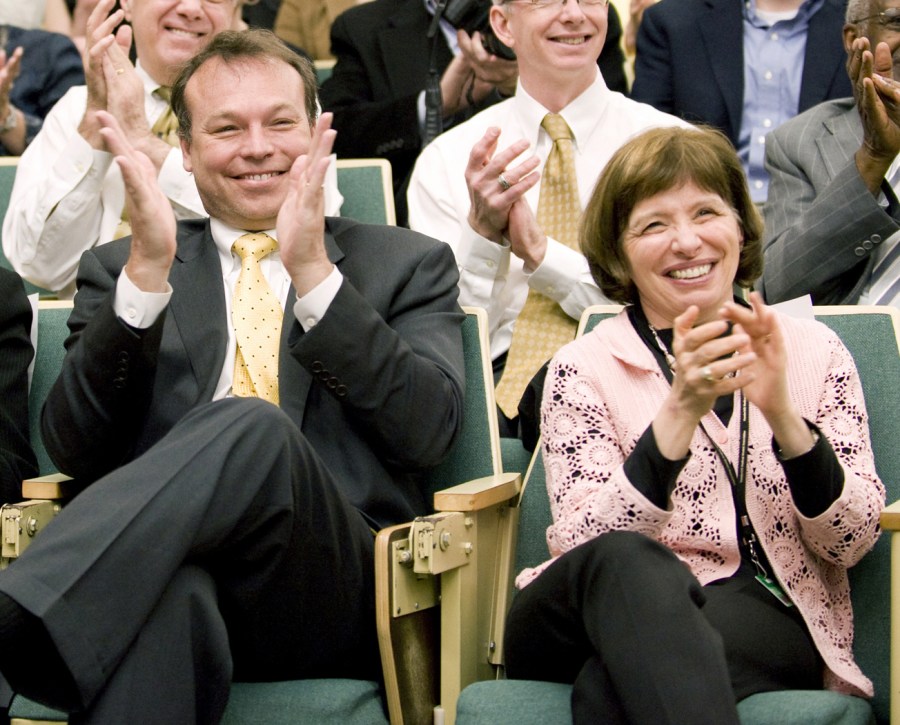
Jeff Balser, M.D., Ph.D., calls Miller an ‘education change agent’ for her efforts in developing VUSM’s new curriculum. (photo by Joe Howell)
“She is a writer, poet, quilter, and there is an artistic side to her that is refreshing,” Tarpley said. “She is not a mechanistically driven careerist; she is a thinker and a feeler. But she can channel her inner surgeon. You can be sure of that.”
The Rev. Mary Lou O’Gorman, the chaplain at Saint Thomas, said Miller had a way of revering others, including students and patients.
“She has an ability to translate that message from her own practice: to know that to be a physician is not to have ‘power over,’ it’s a partnership in healing,” O’Gorman said.
Kim Lomis, M.D., joined Miller and Ballinger in practice at Saint Thomas and says her regard for Miller deepened because of both the respect she felt for her, and for Miller’s commitment to her values.
Lomis recalled difficult years when the group accepted TennCare patients when other general surgeons stopped seeing them; but she was proud to be part of a practice that would not turn patients away. Lomis says the surgical chief resident portraits that line the hall in the Department of Surgery on the fourth floor of Medical Center North illustrate what inspires her about Miller.
“If you walk down the hallway, you have to walk 50 years before you find a woman’s portrait. Jeanne (Ballinger) was the third one trained here, and Bonnie was sixth. You might think that someone who scrapped her way through would mimic the style she saw, and some women do evolve into those around them, but not Bonnie. That’s why I think she has such inner strength. She had a vision for a different way leadership could work,” Lomis said.
In 1998, when Miller was ready to leave Saint Thomas, she approached Tarpley about joining the Veterans Administration Hospital.
“We didn’t have a salary line, so she worked six months without compensation until I could arrange a salary for her,” Tarpley recalled.
Leading by example
Risks like this were no small matter. The Millers had three children to raise along the way. Ellen, the eldest, lives in Cambridge, Mass., where she is a first-year MBA student and is married to Gregg Herlacher, a software engineer. Nathan graduated from film school in New York City, but recently found a new passion working with the chronically homeless in Queens. Their youngest, Miriam, attends college in Pennsylvania.
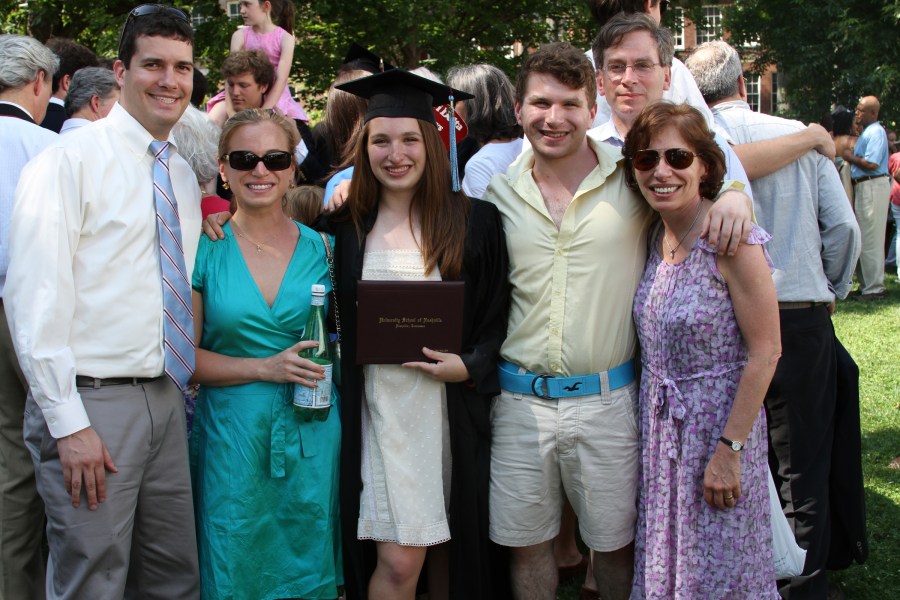
The Millers are intensely proud of their three children: Ellen, second from left, with her husband, Gregg Herlacher, Miriam and Nathan.
“Balance? The children would probably say we didn’t find it. But we have enjoyed the craziness of it all and it really has raced by,” Miller said. “It’s life… you go to bed every night and you wake up every morning and 20 years have gone by and your kids are grown.”
Robert Miller has a similar sense that there was more dynamism than balance. He says he relished bringing issues to debate to the dinner table, but he and Bonnie have never had to push their children to be involved.
“Our kids are very different from one another, but they all feel strongly about the world around them. We’re very proud of that,” he said.
Despite doubts about their own parenting, the Millers agree things turned out well.
“My pediatrician once listened to me complain about how busy the children kept us and he said, “Well Bonnie, your children have never been doormats,” he recalled with a laugh.
Ultimately, the Millers’ parenting practices came down to leading by example. In a similar fashion, colleagues at Vanderbilt say, whether they mean to or not, that’s what the Millers have always done.
An excellent example is the development of the Shade Tree Clinic. Lomis recalls the student-run free health clinic in East Nashville was the idea of a couple of students who wanted to offer a health service to those without insurance. Bonnie supported the idea and gave the necessary permissions along the way while Robert became fully smitten with the critical services students could provide through Shade Tree.
Today, Robert is well-known for his tireless work as co-medical director and vocal advocate for the Shade Tree Clinic, which provides primary health care to hundreds of Nashvillians.
“It was great how she facilitated the process and then got Bob to do all this free work,” Lomis joked. “In all seriousness, I think their lives and the things they do reflect their principles.”
But both Millers say it’s simple to believe in and support people who have good ideas.
Trust in others
As Tarpley recalls, it was the medical students who came to Bonnie in 1999, asking her to apply for associate dean of Students. She got the job, and within five years was asked to serve as associate dean for Undergraduate Medical Education and establish a new office of medical education, now known as the Office for Teaching and Learning in Medicine.
Scott Rodgers, M.D., was hired to replace Miller as dean of Students and she was asked to focus on the curriculum, and, more urgently, to usher in a new curriculum.
“We needed a change,” Miller said. “The traditional curriculum was no longer consistent with how people use science to provide up-to-date medical care. It was time for us to incorporate new research and concepts about how people learn and how they apply what they learn. We needed to evolve,” she said.
Neil Osheroff, Ph.D., the John G. Coniglio Chair in Biochemistry, who taught first- and second-year medical students, remembers that at first he was skeptical about the curriculum changes.
“The most creative force at any university is the faculty, until it comes to the curriculum and then we are the most intractable lot you can possibly find,” Osheroff said. “But ultimately you need someone who keeps the vision, someone who knows that if we get from here to here it will be a much better place to be. That was Bonnie.”
Miller’s leadership style is described as non-traditional, natural, unforced, even unexpected. And, according to even one former skeptic, so firmly rooted in faith and trust in others that it’s hard to resist. Osheroff says he discovered, much to his surprise, he liked the new classes much better and was having fun teaching them.
It was Osheroff who nominated Bonnie for the Medical School¹s Gerald S.
Gotterer Award for Innovation in Educational Programming, an award she
received in May 2011 at the VUMC Spring Faculty Meeting.
Gotterer, M.D., Ph.D., emeritus professor of Medical Education and Administration, says Miller astutely laid the groundwork for success by taking a realist's approach. She garnered expanded financial support for faculty involvement with teaching, which allowed faculty to commit time and energy to the curricular change without experiencing a literal cost from this shift in their focus. It was fair and equitable, and felt that way to faculty.
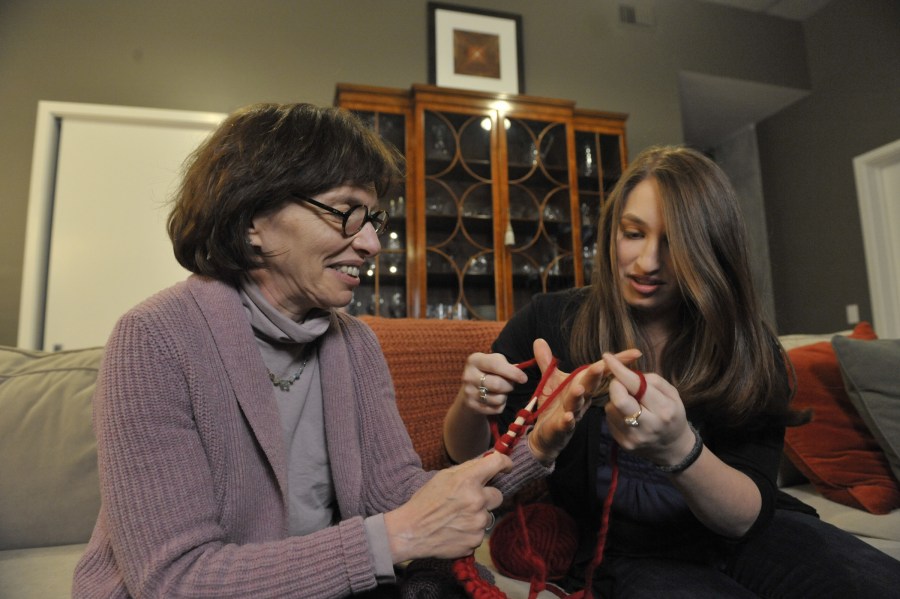
Miller enjoys some quiet time at home with her youngest daughter, Miriam, who attends college in Pennsylvania. (photo by Joe Howell)
“I would sit in on the meetings three or four years ago, and watch the change,” Gotterer said. “In the past they would say our students are fine, and our time is needed elsewhere. Now people are willing to look at national trends and consider change. There is a willingness and interest in progressing the curriculum,” Gotterer said.
Go time
A critical meeting this past January held the proof of what has occurred on Miller’s watch. The Curriculum 2.0 Steering Committee faced a “go-no-go” decision about giving the final green light for full roll-out in the summer of 2013.
But that day someone in the meeting brought up the fact that this was perhaps the last opportunity to reconsider whether they should do this at all. Was this curriculum change, in fact, the right thing to do? Were they sure it was good for the faculty and the students?
Miller didn’t have to say a word. The room erupted. Of course they would do it. This was the time and Vanderbilt was ready. It was a defining moment. That reaction showed that belief in the new curriculum was broadly shared.
“In a traditional sense, you wouldn’t necessarily see Bonnie as a change agent, but she has found her own way to foster it,” Lomis said.
“I think what made things work was Bonnie,” Osheroff said. “Vanderbilt has long been known for great clinical care and great research, but we have not been known for curricular research, and we are perched on the edge of that. Now Vanderbilt is one of the few places that can pull this off.”
Miller said that meeting was also pivotal for her. She said as she walked home that night she had a sense that at some level the real heavy lifting was done.
“No more bull whip or megaphone. This is the faculty’s project. Now I know the change will go on with or without me,” she said.
The fact that no one seems to have felt the bullwhip or heard a megaphone over all this time speaks volumes about Miller.
On her watch, perhaps only through pain that Miller knows, the faculty has proven what they are capable of, and is ready to achieve much more.













